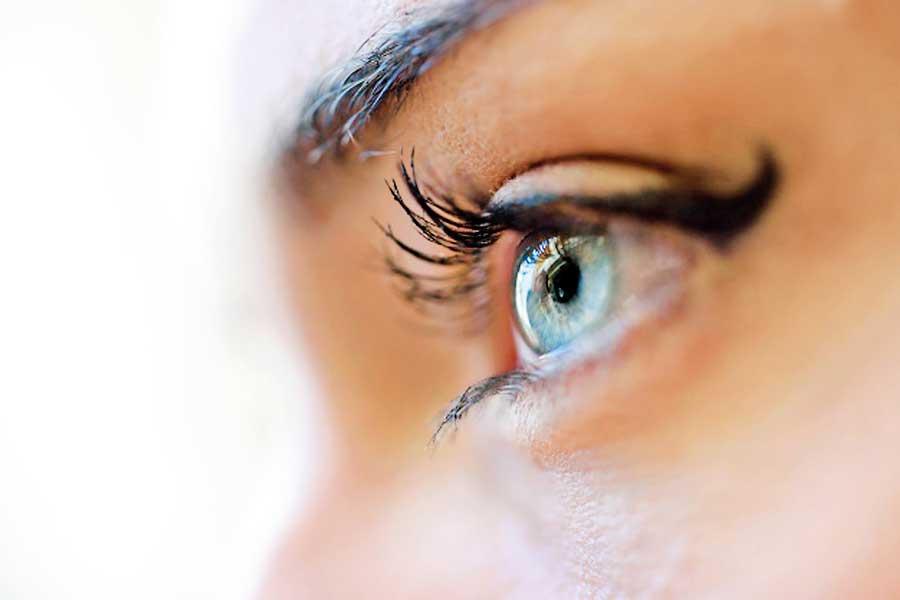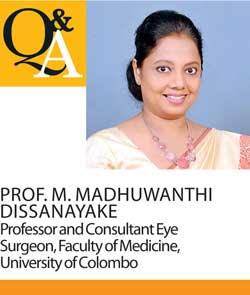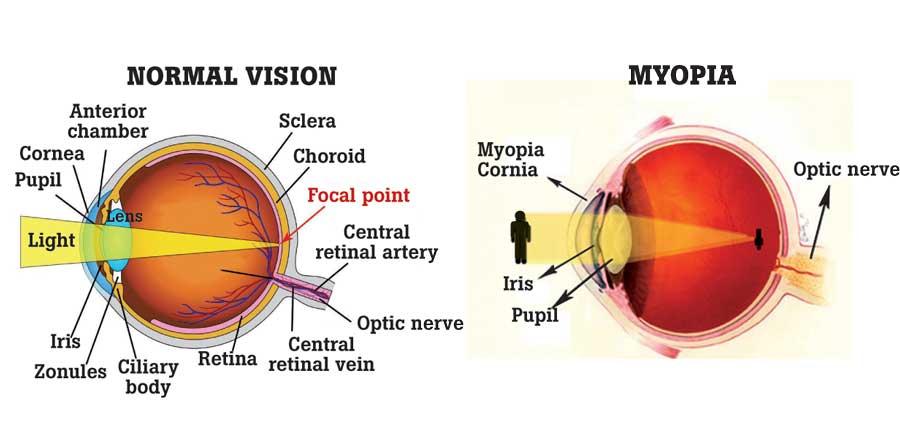20 Dec 2019 - {{hitsCtrl.values.hits}}

 Vision is as important as every other sense and organ in our body. But due to age and lifestyle changes vision could get weaker with time. In a study done in 2010, uncorrected refractive errors wereknown to be the most common cause of distance vision impairment, affecting 108 million persons globally. It was also the second-most cause of blindness globally. But it has been predicted that in 2050 about 50% of the global population will be affected by myopia. In Sri Lanka also it’s a common problem. In an islandwide survey done for people over 40 years of age, the prevalence was 17% apart from those with cataract.
Vision is as important as every other sense and organ in our body. But due to age and lifestyle changes vision could get weaker with time. In a study done in 2010, uncorrected refractive errors wereknown to be the most common cause of distance vision impairment, affecting 108 million persons globally. It was also the second-most cause of blindness globally. But it has been predicted that in 2050 about 50% of the global population will be affected by myopia. In Sri Lanka also it’s a common problem. In an islandwide survey done for people over 40 years of age, the prevalence was 17% apart from those with cataract.
With that in mind the Mirror Health Capsule spoke to Prof. M. Madhuwanthi Dissanayake, Professor and Consultant Eye Surgeon, Faculty of Medicine, University of Colombo who spoke about Myopia in detail.
What is Myopia?
According to Prof. Dissanayake, Myopia also called nearsightedness is one of the refractive errors where the image formedinside the eye is not clear.
In myopia the image forms in front of the retina. This resultsfrom either the eye ball being too large or due to the condensing power of the cornea or the lens being too high. “Out of the two the axial length or the length of the eyeball being longer is the common cause in children and young adults. But later on if the lens gets affectedby age due toconditions such as cataract where lens proteins change, the lens powerwill increase. This is known as Index myopia and it happens with advancing age.
The other refractive errors where a clear image is not formed on the retina include farsightedness (Hypermetropia) and astigmatism.
In nearsightedness what is not clear are the faraway objects.”
“Myopia which is greater than 5-6 dioptresis called high myopia. High myopiacan be associated with other problems such as retinal degeneration, retinal detachment, glaucoma, lens being in a different position and other systemic illnesses. Thereforehigh myopic children should also be checked for other diseases such as Marfan syndrome. Also children with some systemic disease such as Down’s syndrome should be referred for eye checks. Therefore it’s important to pay special attention to people with high myopia andIf they get any symptoms such as floaters or flashing lights then the retina has to be checked to prevent sudden vision loss.”
Symptoms
Blurring of the image – distant objects appear blurred in myopia. Therefore, people with myopiacannot recognize faces in a crowd and social interaction is poor.
In Sri Lanka we get most number of references from teachers as children having difficulty with school work are first noticed by vigilant teachers.
Headache - While seated at the back, children try to look harder and focus. After some time, their eye muscles get tired and they get headaches.
Eye fatigue
Initially they try to focus after some time it gives way and at that point they can’t see anything
Squinting – this is where you see people partially closing their eyes when in bright areas. You sometimes see children narrowing their eyes or closing eyes partially. This helps to cut of peripheral rays and make them see better from the light rays passing through the central part of the pupil making the vision clearer temporary.
Children moving closer to a TV or students moving to the front rows in a class to see what’s written in a board.

Diagnosis
“Diagnosis can be done at the Ophthalmologists (doctorsspecializing in eye) or at optometrists (persons trained in checking the vision and determining the spectacles) in state sector and private sector hospitals,” she continued. “But these can be associated with other systemic problems. Therefore initial consultation could be done by a doctor followed by an optometrist.
Sometimes diagnosis will be done after putting a few eye drops to dilate the pupil and check the full refractive error. In that situation a doctor’s prescription is needed. This occurs in children and therefore they first need to visit a doctor. After diagnosis we need to make sure that the child wears the spectacles all the time except when bathing and sleeping. Otherwise the necessary effect will not be there. Thereafter, the rechecking the glasses (refraction) has to be checked every 6 months for children below 18 years. If it is just within about dioptre within the year it can be changed, if the change is gross it is better to be checked by a doctor. Normally with the height of the child the axial length of the eye ball also increases. This happens rapidly between 13-18 years but after 18years it will stabilize. Some parents are worried about their child’s vision failing but if they can read the last line 6/6 in the chart spectacles, it is normal. If it gets weakerhas to be checked and special treatment may be needed.”
Treatment
Spectacles are one option. “We use a conclave lens for myopia to open up the rays, thereby allowing the image to form further away right on the retina,” she added. “If the image forms behind the retina we then use a convex lens to get the image towards us on the retina. Nowadays there are technically advanced materials where with the slightest change of the thickness you can make a higher power difference also known as high index lenses. The refractive index of the material will tell you how much power it can generate. Nowadays people with high myopia can use normal glasses because the material is technologically advanced.
Contact lenses are another option whichcould be used even on small children but there are problems such as infections, changes on corneal surface etc.The cornea gets its oxygen supply from outside since there are no blood vessels taking oxygen into the cornea and it needs to be exposed. This is why we have gas permeable contact lenses. Therefore contact lenses have to be removed at night. If not used properly, the cornea will get swollen and will be prone to infections. For adults we have another option;lasersurgery after 21 years. Here, we carve the necessary curvature on the cornea and by removing some normal tissue from the cornea. One problem with laser surgery is that we are removing normal tissues to reshape the cornea and it is an irreversible procedure.There should be a minimum thicknessafter surgery and the refractive error should be in that limit and the corneal thickness should have a certain thickness. Otherwise it will break. Bifocal glasses for children are a new option as well as pharmacological methods such as eye drops. With these methods we try to limit the progression of myopia. At the moment it is used in children who show rapid progression.”
How lifestyle changes could help
Prof. Dissanayake further said that prevalence of myopia increases due to lifestyle patterns. “Time spent outdoors during childhood may reduce the progression of myopia in children and adolescents. When they play outside the endorphins created in the body will reduce progression of myopia. Back in the day there was one period of physical education but nowadays teachers take that period off to teach a subject. So we need to make it compulsory to have physical education in schools. They need to play outside in sunlight and as a result, distance vision mechanisms will come into play. Other factor is vitamin D which allows bones to act and collagen to work. Although we are living in a tropical country we are not using what is given free to us, but now we see children taking vitamin D supplements. Therefore we need to utilize the resources we have. Children also need to engage in playtime activities in order to stimulate the brain and endorphin activity to increase. That environment has to be created if we need a healthier generation and there’s a high chance of Myopia progressing if these changes don’t happen.”
In her concluding remarks Prof. Dissanayake said that since children can read numbers and letters by the time they are in Grade One, parents should take them to MOH Clinic, hospital or an optometrist and get their eyesight checked. Special clinics are also available at Lady Ridgeway children’s hospital (LRH) for eye checking.
“Sometimes one eye may not be normal. If it is not corrected within that period it cannot be reversed. In other countries there are pre-school vision checks but not here. We are trying to make it a policy but it hasn’t happened yet. By about 7-8 years we should be able to get the vision back quickly. By 18 many young adults come to get their eyesight checked to apply for the driving license but it would be too late. By then it’s irreversible and we cannot do anything. It’s a failure in our system as well.”
21 Dec 2024 5 hours ago
21 Dec 2024 21 Dec 2024
21 Dec 2024 21 Dec 2024
21 Dec 2024 21 Dec 2024
21 Dec 2024 21 Dec 2024